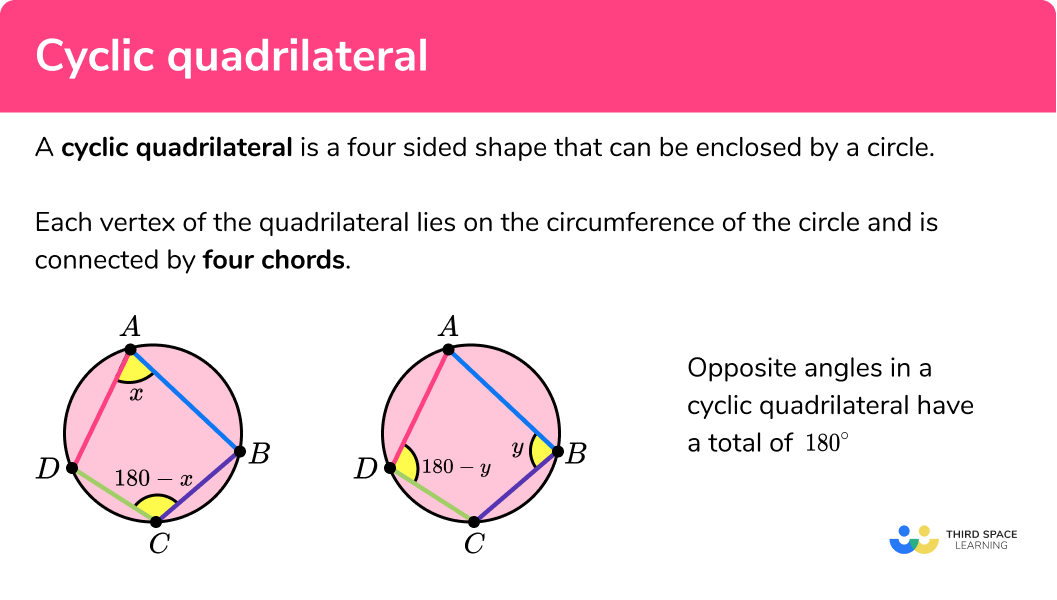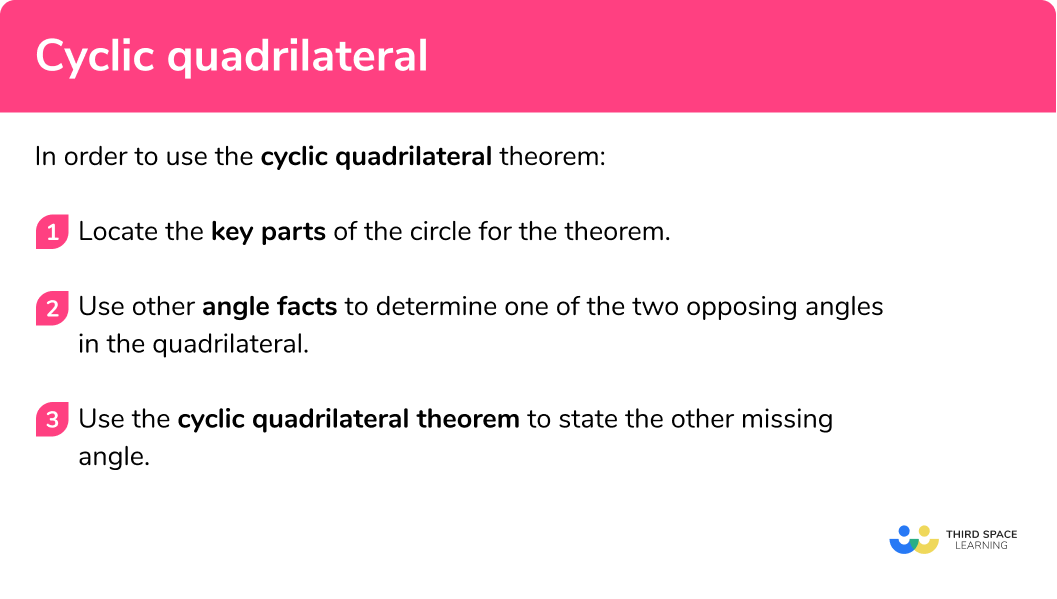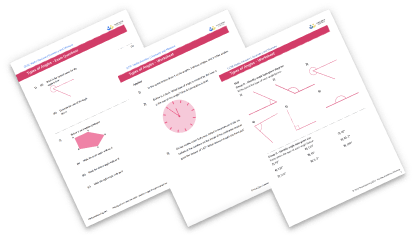GCSE Tutoring Programme
Our chosen students improved 1.19 of a grade on average - 0.45 more than those who didn't have the tutoring.
In order to access this I need to be confident with:
Parts of a circle Angles in polygons Angles on a straight line Angles around a point Angles in parallel linesProperties of triangles
This topic is relevant for:

Cyclic Quadrilateral
Here we will learn about the circle theorem involving cyclic quadrilaterals, including its application, proof, and using it to solve more difficult problems.
There are also circle theorem worksheets based on Edexcel, AQA and OCR exam questions, along with further guidance on where to go next if you’re still stuck.
What is a cyclic quadrilateral?
A cyclic quadrilateral is a four sided shape that can be inscribed into a circle. Each vertex of the quadrilateral lies on the circumference of the circle and is connected by four chords.
The opposite angles of a cyclic quadrilateral have a total of 180°.
In the diagrams above, the points A, B, C, and D are on the circumference of the circle.
The opposite angles of a cyclic quadrilateral have a total of 180° and so they are supplementary to one another. This means that the angle at A plus the angle at C is equal to 180° , and the angle at B plus the angle at D equal 180° .
This also highlights that angles inside a cyclic quadrilateral total 360° , which is the same property for any quadrilateral.
What is a cyclic quadrilateral?

Key parts of a circle needed for this theorem
- The centre of the circle is a point that locates the middle of a circle (the midpoint of the circle).
- The circumference of the circle is the distance around the edge of the circle.
- A chord is a straight line that meets the circumference in two places. The longest chord in a circle is the diameter.
Proving that opposite angles of a cyclic quadrilateral total 180°
To be able to prove that opposite angles of a cyclic quadrilateral total 180° , you need to know the following circle theorems:
- The angle at the centre is twice the angle at the circumference
| Step | Diagram | Description |
| 1 | ABCD is a quadrilateral inscribed by a circle with centre O. | |
| 2 | By drawing two radii from OB and OD, we can split the quadrilateral into two smaller quadrilaterals that tessellate around the centre of the circle. | |
| 3 | If the angle A is labelled a, the angle BOD is equal to 2a as the angle at the centre is twice the angle at the circumference. | |
| 4 | If the angle at C is labelled c, the other angle at BOD is equal to 2c for the same reason as in Step 3. | |
| 5 | This means that we have the point at the centre with the angles 2a and 2c. | |
| Angles around a point total 360° | Therefore, we can state that 2 a + 2 c = 360 Or by simplifying it (dividing throughout by 2): a + c = 180° This means that opposite angles of a cyclic quadrilateral total 180°. |
How to use the cyclic quadrilateral theorem
In order to use the cyclic quadrilateral theorem:
- Locate the key parts of the circle for the theorem.
- Use other angle facts to determine one of the two opposing angles in the quadrilateral.
- Use the cyclic quadrilateral theorem to state the other missing angle.
How to use the cyclic quadrilateral theorem


Cyclic quadrilateral worksheet

Get your free cyclic quadrilaterals worksheet of 20+ questions and answers. Includes reasoning and applied questions.
DOWNLOAD FREE
Cyclic quadrilateral worksheet

Get your free cyclic quadrilaterals worksheet of 20+ questions and answers. Includes reasoning and applied questions.
DOWNLOAD FREERelated circle theorems
Tangent of a circle is one of 7 circle theorems you will need to know. You may find it helpful to start with our main circle theorems page and then look in detail at the rest.
Cyclic quadrilateral examples
Example 1: standard diagram
ABCD is a cyclic quadrilateral. Calculate the size of angle BCD :
- Locate the key parts of the circle for the theorem.
Here we have:
- The angle BAD = 51°
- The angle BCD = θ
2Use other angle facts to determine one of the two opposing angles in the quadrilateral.
We already know that BAD = 51° so we do not need to use any other angle fact to determine this angle for this example.
3Use the cyclic quadrilateral theorem to state the other missing angle.
As opposite angles of a cyclic quadrilateral total 180° , we can calculate the size of angle BCD :
Example 2: unnecessary information
ABCD is a cyclic quadrilateral. Calculate the size of angle BAD :
Locate the key parts of the circle for the theorem.
Here we have:
- The angle BCD = 105°
- The angle ABC = 138°
- The angle BAD = θ
Use other angle facts to determine one of the two opposing angles in the quadrilateral.
We already know that BCD = 105° so we do not need to use any other angle fact to determine this angle for this example.
Top tip: sometimes you are given extra information that you need to filter through in order to use what you need, rather than using everything you have been given. It is important to know what information is important, and what is irrelevant.
Use the cyclic quadrilateral theorem to state the other missing angle.
As opposite angles of a cyclic quadrilateral total 180° , we can calculate the size of angle BAD :
Example 3: angles in a semicircle
ABCD is a cyclic quadrilateral with center O . Calculate the size of angle ABC .
Locate the key parts of the circle for the theorem.
Here we have:
- The angle ADB = 35°
- The angle BDC = 64°
- The angle BCD = angle BAD = 90°
- The angle ABC = θ
Use other angle facts to determine one of the two opposing angles in the quadrilateral.
We already know angle BDA and angle CDB and so together they are opposite the angle ABC . This means that we can calculate ADC :
Use the cyclic quadrilateral theorem to state the other missing angle.
As opposite angles of a cyclic quadrilateral total 180° , we can calculate the size of angle ABC :
Example 4: isosceles triangles
ABCD is a cyclic quadrilateral inside a circle with centre O . BOC is the inscribed angle of the chord BC . Calculate the size of angle ADC .
Locate the key parts of the circle for the theorem.
Here we have:
- The angle ABO = 48°
- The angle BOC = 100°
- The angle ADC = θ
Use other angle facts to determine one of the two opposing angles in the quadrilateral.
OBC is an isosceles triangle because OB and OC are radii of the circle. This means that the other two angles in the triangle are the same size, so angle OBC can be calculated:
As angle OBC=40° , we can now calculate angle ABC , which is the angle opposite angle ADC .
Use the cyclic quadrilateral theorem to state the other missing angle.
As opposite angles of a cyclic quadrilateral total 180° , we can calculate the size of angle ADC :
Example 5: angles in triangles
The circle below contains the quadrilateral ABCD . Calculate the size of angle CAD :
Locate the key parts of the circle for the theorem.
Here we have:
- The angle BDC = 36°
- The angle CBD = 58°
- The angle AEB = 119°
- The angle CAD = θ
Use other angle facts to determine one of the two opposing angles in the quadrilateral.
We need to determine the size of angle BCD in order to find the size of angle θ. Using angle AEB , we can determine all the angles around the point. Angles on a straight line total 180° and so angle BEC = AED = 180 - 119 = 61° . Vertically opposite angles are equal so angle CED = 119°
We can now calculate angle BCD by finding angles BCE and DCE using angles in triangles total 180° .
Finally we can calculate the size of the angle CAB . This is because angles in the same segment are equal and so angle CAB = angle BDC . CAB = 36° .
Use the cyclic quadrilateral theorem to state the other missing angle.
As opposite angles of a cyclic quadrilateral total 180° , we can calculate the size of angle BAD :
As we know that angle BAD = 94° and angle angle BAC = 36° , we can finally calculate the size of angle CAD :
Example 6: tangents to a circle
ABCD are vertices of the quadrilateral inscribed in a circle with centre E . BF and CF are tangents to the circle with centre E . Calculate the size of angle CDE .
Locate the key parts of the circle for the theorem.
Here we have:
- The angle BEC = 90°
- The angle CDE = θ
- BF and CF are tangents
- AC and BD are diameters
Use other angle facts to determine one of the two opposing angles in the quadrilateral.
As AC and BD are perpendicular bisectors, BE and CE are radii that meet at 90° .
EBF and ECF are 90° angles because the angle between the tangent and the radius is 90° . Tangents that meet at the same point are equal length and so BE and CF must be parallel and CE and BF are also parallel. All the sides are the same length, and meet at a right angle.
As opposite sides of the quadrilateral are equal and perpendicular to each other, BECF is a square.
As AC is a diameter, angles in a semicircle equal 90° so angle ABC = 90° .
Use the cyclic quadrilateral theorem to state the other missing angle.
As opposite angles of a cyclic quadrilateral total 180° , we can calculate the size of angle ADC :
AC and BD are perpendicular and they are both diameters. The intersection of the diagonals of the quadrilateral are at right angles to each other, so ABCD is a square. This means that the line BD is a diagonal, which bisects the angle ADC . This means that we can calculate the size of angle CDE :
Common misconceptions
- Angle at the centre is supplementary to opposing angle
As the shape is a quadrilateral, the angle at the centre is assumed to be supplementary and add to 180° .
- Opposite angles are the same
As angles in the same segment are equal, the opposing angles in a quadrilateral are assumed to be equal. The only case of this is when both angles are 90° . As angles in the same segment are equal, the opposing angles in a quadrilateral are assumed to be equal. The only case of this is when both angles are 90° .
- Opposite angles are double
Similar to the angle at the centre theorem, it is assumed that the opposing angle in a cyclic quadrilateral is double or half of the other.
- Opposite angles don’t add up to 180°
The angles in a cyclic quadrilateral are calculated incorrectly (usually after forming and solving an equation and so the opposite angles do not add to 180° .
Practice cyclic quadrilateral questions
1. ABCD is a cyclic quadrilateral. Calculate the size of angle ABC .




180-63=117^{\circ} (opposite angles of a cyclic quadrilateral total 180^{\circ} )
2. The circle with centre O has four points on the circumference at A, B, C, and D . Without using a protractor, calculate the size of angle BCD marked \theta .




180-85=95^{\circ} (opposite angles of a cyclic quadrilateral total 180^{\circ} )
3. ABCD is a cyclic quadrilateral. The line AC passes through the centre O and angle BAD = 107^{\circ} . Calculate the size of angle \theta .




- 180-107=73^{\circ} (opposite angles of a cyclic quadrilateral total 180^{\circ} )
- 73-61=12^{\circ}
4. The points A, B, and D are on the circumference of a circle with centre C . Calculate the size of the interior angle BAD .




- 360-122=238^{\circ} (angles around a point total 360^{\circ} )
- 238\div2=119^{\circ}
5. ABCD is a cyclic quadrilateral. The chords AC and BD intersect at the point E . calculate the size of angle ACD .




- 180-(18+39)=123^{\circ} (opposite angles of a cyclic quadrilateral total 180^{\circ} )
- ACB = 31^{\circ} as angles in the same segment are equal.
- 123-31=92^{\circ}
6. The circle with centre O contains a cyclic quadrilateral. The line EF is a tangent at point D where angle CDF = 43^{\circ} . Calculate the size of angle OBC .




- ODF = 90^{\circ} so OCD = 90-43 = 47^{\circ} (tangent and radius meet at 90^{\circ} )
- BOD=78\times2=156^{\circ} (angle at the centre is twice the angle at the circumference)
- BCD=180-78=102^{\circ} (opposite angles of a cyclic quadrilateral total 180^{\circ} )
- OBC=360-(47+156+102)=55^{\circ} (angles in a quadrilateral total 360^{\circ} )
Cyclic quadrilateral GCSE questions
1. PQRS is a quadrilateral inscribed in a circle. Calculate the value of x .
(3 marks)
180 – 124 = 56^{\circ}
(1)
4x=56^{\circ}
(1)
x=14^{\circ}
(1)
2. Below is a semicircle:
(a) Malik says “the angle = 90^{\circ} because the angle in a semicircle is equal to 90 degrees”. Explain why Malik is not correct.
(b) Calculate the size of angle \theta . Justify your answer.
(3 marks)
(a)
The angle in a semicircle is equal to 90^{\circ} when the angle is subtended from the chord A and B .
The angle BCD is subtended from the chord BD and so it does not equal 90^{\circ} as BD is not the diameter of the semicircle.
(1)
(b)
180 – 52 = 128^{\circ}
(1)
Opposite angles in a cyclic quadrilateral total 180^{\circ}
(1)
3. (a) ABCD is an inscribed quadrilateral within a circle. AC and BD intersect at the point E . Use the information given to calculate x , the angle DCE .
(b) Hence calculate the value of y . Justify your answer.
(9 marks)
(a)
ADB = 7^{\circ}
(1)
Angles in the same segment are equal
(1)
CDE = 87 – 7 = 80^{\circ}
(1)
CED = 44^{\circ}
(1)
Vertically opposite angles are equal
(1)
DCE = 180 – (80+44) = 56^{\circ}
(1)
Angles in a triangle total 180^{\circ}
(1)
(b)
180 – (56+7) = 117^{\circ}
(1)
Opposite angles in a cyclic quadrilateral total 180^{\circ}
(1)
Learning checklist
You have now learned how to:
- Apply and prove the standard circle theorems concerning angles, radii, tangents and chords, and use them to prove related results
The next lessons are
Still stuck?
Prepare your KS4 students for maths GCSEs success with Third Space Learning. Weekly online one to one GCSE maths revision lessons delivered by expert maths tutors.

Find out more about our GCSE maths tuition programme.